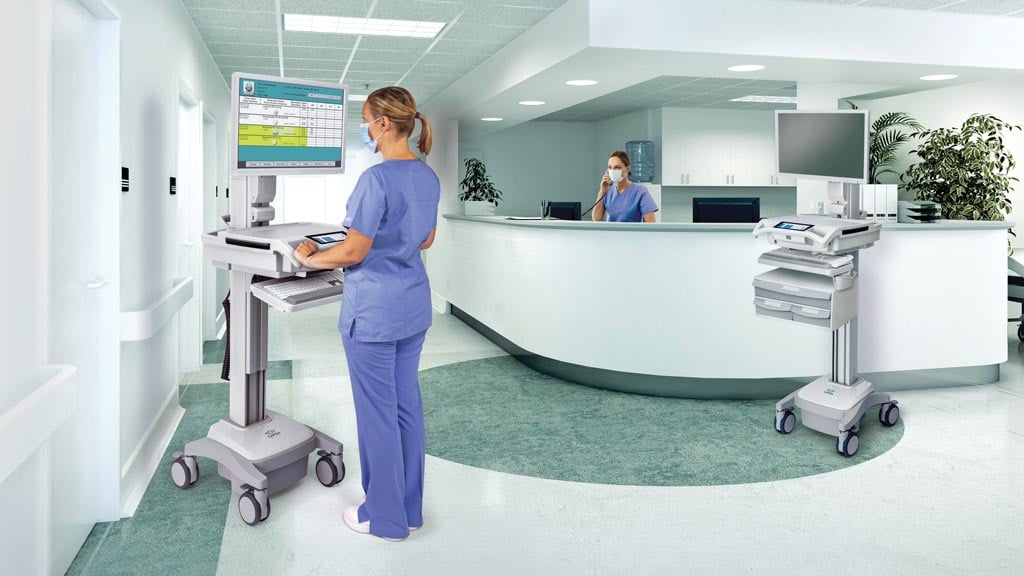Automation in our connected electronic world has changed the way industries operate and conduct business. Most of us can relate to the consumer industry of media, photography and travel. In today's blog, we will explore how automation has impacted the airline industry and how automation can benefit healthcare especially when it comes to locating equipment. In the airline industry, automation has made it efficient to book travel, obtain tickets and makes information readily available at our fingertips. Much like the airline industry, automation is changing the healthcare industry as well. Automating activities that widen access to information, simplify transactions and, ultimately, increase customer satisfaction and save lives.
Imagine a scenario within your facility that deploys real-time automation that allows you to gather business intelligence to have a better understanding on asset utilization, location of assets and know what % of shrinkage is happening within that facility or at the enterprise level.
When I traveled at the start of my career, I had a mailbox at the airport to facilitate quick travel arrangements. This mailbox was used because the airline industry used paper tickets and the only way to board a flight with a paper ticket. If I was booking a flight and needed to travel on the same day, imagine the extra running around to simply pick up a ticket. In those days, one did not book a flight through the airline direct. The process of booking a flight involved contacting my trusted travel agent, who at that time had sole access and insight into current travel options. My travel agent and I would discuss travel options over the phone, select my best travel option and the travel agent purchased the ticket.

The travel agent would make sure a runner dropped the ticket off in my airport mailbox and I would pick it up when i was catching a flight. In those days a paper ticket was worth real money, just like cash. If you held a ticket, no matter whose name was on it, you could travel. Back then, it was not routine to check identification like it is today. Fast forward to today and my continued delight with the automation of the travel industry where I can go online, search options directly on my phone, buy a ticket, and jump aboard a flight using an eTicket.
Unlike the travel industry, not all healthcare facilities have hopped aboard real-time automation as it relates to location tasks. Unfortunately, I have found many hospitals struggling to understand the effectiveness of how real-time automation directly impacts their bottom line; it is like making the move away from paper tickets to eTickets.
- Is it fear of the unknown?
- Failing to understand ROI impact?
- Too many technology options?
Real-time automation as it relates to locating equipment (asset management) within the hospital environment is a smart move towards gaining business intelligence that allows greater insight into managing assets, utilization and shrinkage. It is quantifiable and directly impacts a clinicians valuable time by giving them self-service capabilities to check on equipment status and location.
While onsite at a recent RTLS infrastructure installation, a nurse’s question still resonates in my mind, when she asked what we were installing. I replied, “We are from IMS and are installing an RTLS system that allows you to immediately locate equipment in real time, such as wheel chairs or IV pumps, so you don’t have to spend time searching when it is needed. We simply put a tag on a device, and the system will tell you 24/7 where it is.” The nurse, with a huge smile, said, “I need that! I spend a quarter of my time walking around looking for equipment.”
The reality is that clinicians are spending between 20-25% of staff time searching for equipment. This is a documented reality. Ask around, and you will quickly learn that equipment is hoarded, stashed away, or is simply not available, especially in large, process-heavy hospitals.
Additional benefits of real-time automation on locating equipment includes:
- Enterprise visibility of equipment location and status: ‘available’, ‘unavailable’, ‘dirty’, ‘in-use’, ‘being cleaned’
- Capture interactions between equipment, patients, and staff in real time
- Enable efficient work processes that are measurable and repeatable
- Increase efficiencies in patient care by improving patient satisfaction
- Decrease replacement costs for lost or stolen equipment with location visibility and notifications
- Efficiently maintain inventory; repair and service recalled equipment
- Enable staff to view real-time location of equipment from their preferred devices at a desk or mobile device on-the-go
- Eliminate searching for equipment as needed by automated replenishment with PAR level management in real time
- Understand measured utilization rates of your resources to increase usage and reduce expensive, unneeded capital purchases or extra equipment rental
Is your facility still using the same method of walking the halls searching for equipment like you have always done? What can your facility do to ensure efficient task automation? I would love to hear your comments and discuss the ROI and RTLS automation we can provide your facility. It is real and it is relevant.



